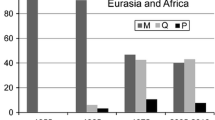Abstract
The P-M system of hybrid dysgenesis was investigated in two Japanese regions, Katsunuma and Ohzu. Most strains were Q in that they did not produce appreciable gonadal dysgenesis with P males or with M females. A few strains produced ambiguous results. Some of these were unstable and on later testing were P, Q or M. Eleven laboratory strains which had been derived from various sites in Japan and had been maintained for 8 to 27 years were also examined. Eight (including all four that were 27 years old) were M, two were Q, and one which had been kept as a large cage population showed some P activity.
Similar content being viewed by others
References
Anxolabéhère D. & Périquet G., 1983. Système P-M de dysgénésie des hybrides, polymorphisme génétique et évolution des populations de Drosophila melanogaster. Génét. Sél. Evol. 15: 31–44.
Anxolabéhère D., Nouaud D. & Périquet G., 1982a. Cytotype polymorphism of the P-M system in two wild populations of Drosophila melanogaster. Proc. natn. Acad. Sci. U.S.A. 79: 7801–7803.
Anxolabéhère D., Nouaud D. & Périquet G., 1982b. Étudode la variabilité du système P-M de dysgénésie de hybrides entre populations de Drosophila melanogaster. C. r. Acad. Sci., Paris 294: 913–918.
Bingham P. M., Kidwell M. G. & Rubin G. M., 1980. The molecular basis of P-M hybrid dysgenesis: The role of the P element, a P-strain-specific transposon family. Cell 29: 995–1004.
Engels W. R., 1979a. Extrachromosomal control of nutability in Drosophila melanogaster. Proc. natn. Acad. Sci. U.S.A. 76: 4011–4015.
Engels W. R., 1979b. Hybrid dysgenesis in Drosophila melanogaster: rules of inheritance of female sterility. Genet. Res., Camb. 33: 219–236.
Engels W. R., 1981a. Germline hypermutability in Drosophila and its relation to hybrid dysgenesis and cytotype. Genetics 98: 565–587.
Engels W. R., 1981b: Hybrid dysgenesis in Drosophila and the stochastic loss hypothesis. Cold Spring Harbor Symp. quant. Biol. 45: 561–565.
Engels W. R., 1983. The P family of transposable elements in Drosophila. Ann. Rev. Genet. 17: 315–344.
Engels W. R. & Preston C. R., 1979. Hybrid dysgenesis in Drosophila melanogaster. The biology of female and male sterility. Genetics 92: 161–174.
Engels W. R. & Preston C. R., 1980. Components of hybrid dysgenesis in a wild population of Drosophila melanogaster. Genetics 95: 111–128.
Hiraizumi Y., 1971. Spontaneous recombination in Drosophila melanogaser males. Proc. natn. Acad. Sci. U.S.A. 68: 268–270.
Kidwell M. G., 1979. Hybrid dysgenesis in Drosophila melanogaster: the relationship between the P-M and I-R interaction systems. Genet. Res., Camb. 33: 205–217.
Kidwell M. G., 1983. Evolution of hybrid dysgenesis determinants in Drosophila melanogaster. Proc. natn. Acad. Sci. U.S.A. 80: 1655–1659.
Kidwell M. G., Kidwell J. F. & Sved J. A. 1977. Hybrid dysgenesis in Drosophila melanogaster: A syndrome of aberrant traits including mutation, sterility and male recombination. Genetics 86: 813–833.
O'hare K. & Rubin G. M., 1982. Structures of P transposable elements of Drosophila melanogaster and their sites of insertion and excision. Cell 34: 25–35.
Ohishi K., Takanashi E. & Chigusa S. I., 1982. Hybrid dysgenesis in natural populations of Drosophila melanogaster in Japan. I. Complete absence of the P factor in an island population. Jap. J. Genet. 57: 423–428.
Picard G. & L'Héritier Ph., 1971. A maternally inherited factor inducing sterility in D. melanogaster. Dros. Inf. Serv. 46: 54.
Rubin G. M., Kidwell M. G. & Bingham P. M., 1982. The molecular basis of P-M hybrid dysgenesis: The nature of induced mutations. Cell 29: 987–994.
Simmons M. J. & Lim J. K., 1980. Site specificity of mutations arising in dysgenic hybrids of Drosophila melanogaster. Proc. natn. Acad. Sci. U.S.A. 77: 6042–6046.
Author information
Authors and Affiliations
Rights and permissions
About this article
Cite this article
Yamamoto, A., Hihara, F. & Watanabe, T.K. Hybrid dysgenesis in Drosophila melanogaster: predominance of Q factor in Japanese populations and its change in the laboratory. Genetica 63, 71–77 (1984). https://doi.org/10.1007/BF00137467
Received:
Accepted:
Issue Date:
DOI: https://doi.org/10.1007/BF00137467




